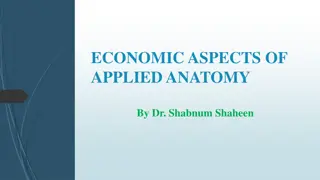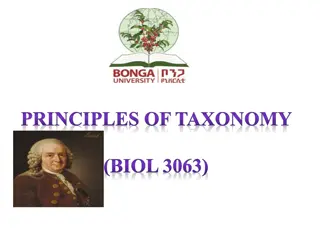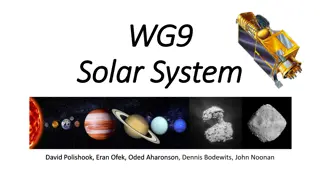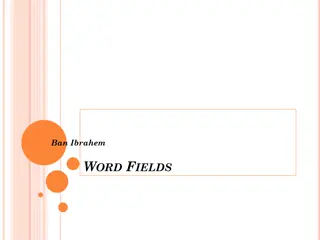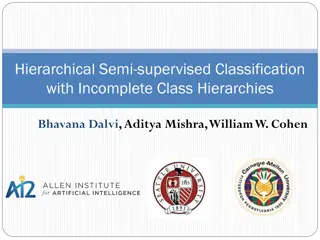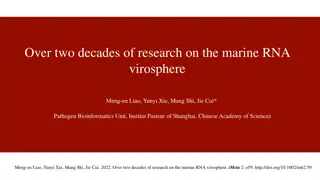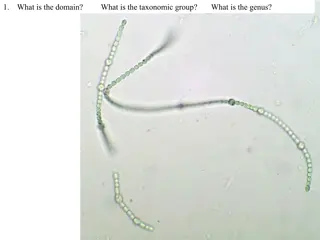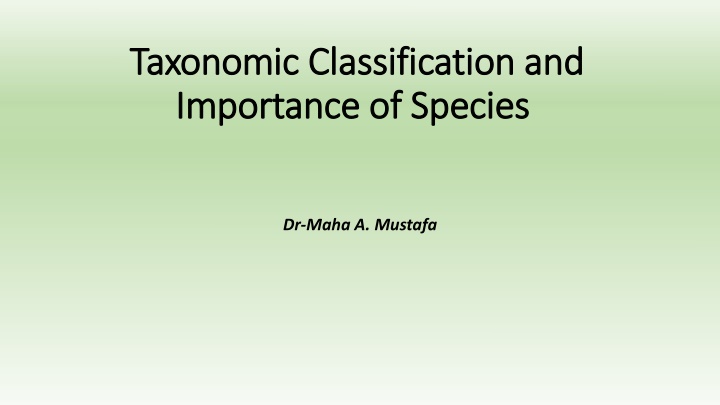
Importance of Taxonomic Classification and Species in Evolutionary Biology
Explore the significance of taxonomic classification in understanding evolution through the lens of species identification and biostratigraphic zonation. Learn how organisms are grouped based on morphological similarities and genetic relationships, highlighting the fundamental role of species in biological studies.
Download Presentation

Please find below an Image/Link to download the presentation.
The content on the website is provided AS IS for your information and personal use only. It may not be sold, licensed, or shared on other websites without obtaining consent from the author. If you encounter any issues during the download, it is possible that the publisher has removed the file from their server.
You are allowed to download the files provided on this website for personal or commercial use, subject to the condition that they are used lawfully. All files are the property of their respective owners.
The content on the website is provided AS IS for your information and personal use only. It may not be sold, licensed, or shared on other websites without obtaining consent from the author.
E N D
Presentation Transcript
Taxonomic Classification and Taxonomic Classification and Importance of Species Importance of Species Dr-Maha A. Mustafa
Taxonomic Classification Taxonomic Classification Organisms can be classified in a variety of ways, including habitat (planktonic, nektonic, benthonic) and environmental distribution (littoral, neritic, bathyal, etc.); however, taxonomic classification based on morphological and develop- mental similarities and presumed genetic relationships is most pertinent to recog- nizing evolution and biostratigraphic zonation. The basic system of taxonomic classification now in use was introduced in 1735 by the Swedish naturalist Lin- naeus, who grouped organisms into a hierarchy of different categories based on the number of distinctive characteristics shared in common. Organisms in the lowest, or least inclusive, category have the greatest number of common charac- teristics; those in the next highest category have fewer common characteristics; and so on, until the highest, or most inclusive, category is reached. In the last cat- egory, organisms share only a very few common characteristics or traits. Lin- naeus's system of classification, as modified illustratedschematically in Figure 14.5. The Linnaean system of taxonomic classification brought to light the fact. by some later additions, is
that degrees of similarities among organisms differ at different levels of classification. Differences among groups of organisms are greatest at the kingdom level Species have thus become the fundamental entity of biostratigraphy. Biologists define species as a breeding community that preserves its genetic identity by its ability to exchange genes with other breeding communities. In other words, all members of a given species have the ability to interbreed, and least at the species level. but they do not normally breed with members of a different species. Thus, a species constitutes a group of interbreeding organisms that are reproductively isolated from other such groups. The criteria for identifying a biologic species are difficult to apply to fossil organisms. Therefore, fossil species are commonly characterized mainly on the basis of shell, or skeletal, morphology. Because the skeletal morphology of different members of the same species can be quite variable, determination of fossil species must be made by taxonomic specialists. Such determination may require quantitative measurements of shell parameters and computer analysis of measurement data to provide statistical rigor to fossil species identification
14.4 14.4 The Basis for The Basis for Biostratigraphic Biostratigraphic Zonation: Changes in Organisms Through Time Zonation: Changes in Organisms Through Time Figure 14.5 Schematic representation of the hierarchical Linnaean system for classifying or- ganisms. All organisms are currently grouped into five kingdoms, about ninety phyla; numerous classes, orders, families, and gen- era; and millions of species. Note that organ- isms at the species level share many common char- acteristics whereas those at higher levels share fewer characteristics
Box Box 14.1 14.1 Models and Rates of Evolution Models and Rates of Evolution There is currently considerable controversy among paleontologists concerning the mode of change in organic evolution. Two principal points of view prevail: One view states that evolution proceeds mainly as a gradual change by slow, steady transformation of well-established lineages-phyletic evolution, or gradualism. The gradualist concept has been the traditional view of species evolution. The second view holds that many species arise very rapidly from small populations of organisms that have become isolated from the parental range and then subsequently change very little after their successful origin. This latter view represents evolution by speciation or branching of lineages, the so-called punctuated equilibria model of Eldredge and Gould (1972). Thus, according to this theory, fossil populations are in stable equilibrium for long periods of time and change very little (called stasis), punctuated by sud- den introduction of new species. Differences in these two postulated modes of evolution are illustrated graphically in Figure 14.1.1. In the punctuational model, speciation, or branching of species, is viewed as a very rapid process.
Figure 14.1.1 Diagrammatic representation of gradualistic and punctuated models of evolution. [Schematic family trees after Stanley, W. H., 1979, Macroevolution, patterns and processes, W. H. Freeman and Company.]
enquiring only tens of thousands of years or possibly as little as a few hundred years (e.g., Stanley, 1979) after a population becomes reproductively isolated from the parent population. Although the duration of species from first appearance to extinction may be measured in millions of years (Table 14.1.1), species are believed by the punctuation lists to change morphologically very little and only very slowly after initial speciation. This concept is stated very succinctly by Elbridge and Gould (1977), who emphasize the importance of speciation (splitting) and claim "that most morphological differences between two species appear in conjunction with the speciation process itself, whereas most of a species' history involves little further change, at least of a progressive nature. Whether species evolution takes place mainly by gradual evolutionary change, mainly by punctuated speciation, or by both, is still a much discussed and debated issue (see, for example, Gould and Elbridge, 1993, and Sheldon, 1996). Both sides of the controversy continue to be aired in the paleontological literature. Some workers propose that certain groups of organisms, such as mammals, tend to evolve by gradual transformation whereas others, such as many marine invertebrates, tend to evolve by punctuated equilibrium. Sheldon (1996) suggests that organisms on land in the tropics and those in the deep sea may tend to undergo continuous, gradualistic evolution, whereas organisms in temperate zones and shallow water tend more toward stasis and occasional punctuations.
Because the majority of the fossil record comes from dynamic shallow-marine environments, many fossil lineages thus show approximate stasis and occasional punctuations. Different groups of species are known to evolve at greatly different rates. Stanley (1985) indicates, for example, that marine bi- valve groups evolve at a rate that yields only three or four species in 20 million years. By contrast, mammalian families evolve at a rate that yields roughly 80 species in 20 million years. From a practical point of view, the task of delineating
Table 14.1.1 Estimated mean species duration (in millions of years) for a variety of biological groups
the boundaries of species is more difficult if evolution occurs by phyletic gradualism because a chain of intermediate species is present in the geologic record and the boundaries between successive species are arbitrary. Thus, it is difficult to pick points in the evolutionary sequence at which distinct species boundaries are recognizable. If, on the other hand, evolution occurs by speciation (punctuated equilibrium), most morphological change presumably occurs at branch intersections in the evolutionary line (Fig. 14.1.1B), which represent discrete points in time. Thus, the task of picking species boundaries should theoretically be easier and less error prone if evolution occurs by speciation rather than by phyletic gradualism. On the other hand, the initial appearance of a new species in different provinces may show a time lag owing to lags in migration, which makes identification of the first-appearance species bound- any more difficult. The practicality of identifying species boundaries, and of establishing the boundaries of biostratigraphic zones, is further complicated by problems in evolving the following: (1) sampling intervals (How small must they be to en- sure that species boundaries are detected?), (2) changes in the fossil record induced by burial and the vagaries of preservation, (3) constancy and rates of sedimentation (smaller sampling intervals are required for sediments that ac- cumulated very slowly vs. those that accumulated very rapidly), and (4) intermittent or punctuated patterns of sedimentation and erosion that yield an incomplete stratigraphic record, thus giving the appearance of punctuated speciation. [For some comparatively recent views on punctuated equilibrium, see Gould (2001) and Kemp (1999, Chapter 7).]
DETERMINISTIC VS. PROBABILISTIC EVOLUTION DETERMINISTIC VS. PROBABILISTIC EVOLUTION An interesting side issue to the problem of evolutionary controls relates to the question of whether or not such evolutionary events as adaptive radiation and periods of mass extinction are deterministic or probabilistic. That is to say, are evolutionary events explainable only in terms of causal factors, or are there statistical laws or generalizations that can explain these events on the basis of random variations or processes? Every human, for example, is destined from the instant of his or her birth to age and eventually die. Is every species like wise destined from the time of its birth (initial speciation) to eventually age and become extinct? Raup (1991, p. 6) states that there is absolutely no basis for equating the life span of species with those of humans and that there is no evidence of aging in species or any known reason why a species could not live forever
. Nonetheless, in a subsequent chapter of his book entitled "Gambler's Ruin and Other Problems," Raup discusses the probability of extinction of a genus with a limited number of species (e.g., ten). If the chance of extinction is identical to that of speciation (fifty-fifty), the number of species will fluctuate up and down as in a random walk but will finally reach zero. Therefore, the laws of probability suggest that eventual extinction of the genus is inevitable (Raup, 1991, p. 49), although the greater the number of species in the genus the longer it will take for extinction to occur. Probabilistic evolutionary models are called stochastic models. Van Valen (1973, p. 1) asserted, for example, that "all groups for which data exist go extinct at a rate that is constant for a given group." Such statements should not be taken to mean that extinctions occur without cause. Extinction of a species may be the result of any number of specific causes and it may, therefore, be in- valid to attribute the death of individuals to chance. If frequency of death is considered at population levels, however, it may be mathematically valid to describe the frequency as being governed by random stochastic processes.
In other words, individuals in a given population of organisms may die owing to various specific causes; however, the population as a whole will become extinct at a constant rate, depending upon its size, regardless of the specific causes of death of the individuals. Thus, in the stochastic approach, the pattern of evolution as a whole is perceived to be a random process, although individual fluctuations in this pattern can be explained by cause and effect. Stochastic models may serve to separate those features of the evolutionary record that are amenable to deterministic explanations from those that do not warrant a search for a specific cause. For example, the fairly rapid demise of the dinosaurs at the end of Cretaceous time can probably be explained by some specific environmental or catastrophic event such as dramatic climatic change resulting from meteorite impact; however, the gradual decline of conodonts and their eventual extinction at the end of the Triassic appears to be more difficult to attribute to a specific cause or causes. Probabilistic extinction can be thought of as a kind of "background" extinction that has acted through- out the fossil record, almost but not quite keeping pace with the rise of new species (global diversity of organisms has increased with time). From time to time, however, major extinction events, called mass extinctions, have occurred and demand a specific causal explanation.
MASS EXTINCTIONS MASS EXTINCTIONS Extinction:The dying out of a whole group of animals. The fossil record shows that the diversity of both marine and continental life has increased exponentially since the end of the Precambrian (e.g., Benton, 1995; Miller, 2000); however, the record also shows that many groups of organisms became extinct or suffered dramatic reductions in numbers and diversity at particular times. During the past two decades, these episodes of mass extinction have assumed increasing importance to paleontologists and other geologists, judging by the rapid appearance of new articles and books dealing with mass extinctions. Five extinction events have become so important and far reaching that they are now commonly referred to as the big five. These major extinction episodes took place near the end of the Ordovician, Devonian, Permian, Triassic, and Cretaceous (Fig. 14.1.2), and the later extinctions affected both terrestrial and marine forms.
As shown in Table As shown in Table 14.1.2 14.1.2, , 47 47- -82 82 percent of extant marine animal genera percent of extant marine animal genera became extinct during these five major mass extinction episodes and 16-51 percent of the marine animal families became extinct. Such dramatic extinctions demand an explanation linked to some specific cause or causes. Particularly important groups of organisms that became extinct include trilobites and Fusulinid foraminifers (Late Permian), conodonts (Late Triassic), and ammonites and dinosaurs (Late Cretaceous). Many other groups also became extinct or were greatly reduced in numbers. These dramatic extinctions have taxed the imagination of paleontologists and other geologists to provide acceptable causal explanations. The Late Permian extinction phase has received particular attention because of the number of major groups affected and the sharpness of the change with which these groups disappeared from the geo- logic record at the end of the Permian.
Mass extinctions are of enormous interest to geologists because of the questions they raise, among other things, about possible recurring catastrophic events in Earth's history. The past few decades saw explosive growth in research into the patterns, rates, causes, and consequences of extinction but little overall agreement about the causes of extinction. Theories about extinction fall into three groups: catastrophic extinction, gradual extinction, and stepwise. Figure 14.1.2 Diversity genera during Phanerozoic time. Arrows point to the "big five," the five great mass extinctions. [After Sepkoski, J. J., Jr., 1995, Patterns of Phanerozoic perspective from bases, in Walliser, O.H. (ed.), Global events stratigraphy: Berlin, Fig. 1, p. 38.] of marine animal genera) (number of extinction: global a data and event Springer-Verlag,
Table 14.1.2 Percentage of decline in marine animal diversity associated with the five great mass extinctions shown in Figure 14.1.2
extinction (extinction that occurs in a series of discrete steps in the vicinity of major stratigraphic boundaries, such as the Permian/Triassic boundary). These various theories have been expounded in numerous research papers and a number of recent books, some of which are listed at the end of this chapter. Causes proposed for the main mass-extinction events are summarized in Figure 14.1.3. Proponents of the catastrophic theory, especially for the sharp Cretaceous/Tertiary boundary event, suggest that the impact of extraterrestrial objects called bolides (meteorites and comets) created major climatic change (global winter) by throwing up huge clouds of dust and/or generated acid rain, tsunamis, and wildfires that caused extinction of some taxonomic groups. Alternatively, intense explosive volcanic activity may have adversely affected climates through discharge of excessive gas clouds (greenhouse warming). Other geologists suggest that such extraterrestrial causes are not needed to explain most extinction events. Gradual, progressive changes in cli- mate (either warming or cooling) together with changes in sea level are adequate, they say, to account for extinctions. For example, lowering of sea level during major episodes of regression reduces habitats for shallow-water organ- isms and increases competition. On the other hand, widespread marine transgressions appear to be linked to development of anoxic (low oxygen) conditions that adversely affect some organisms and cause extinction (Hallam and Wignall, 1997, p. 251). The actual causes of anoxia during phases of transgression are poorly understood. Still other geologists suggest that some extinctions occur in a stepwise fashion by a series of pulses-some before, some at, and some just after a major boundary. These extinctions are presumably the result of a succession of events, such as brief showers of comets superimposed on a background of progressive environmental deterioration.
In any event, worldwide extinctions of major groups of organisms, while extremely interesting and significant, play only a limited role in biostratigraphy because these major extinctions provide only a few correlation horizons. Changing local environmental conditions are probably a more significant cause of extinction of individual species, which form the most important basis for biostratigraphy.
Figure 14.1.3Proposed causes for the main Phanerozoic extinction events. [After Hallam, A., and P. B. Wignall, 1997, Mass extinctions and their aftermath: Oxford University Press, Table 11.1, p. 248.



